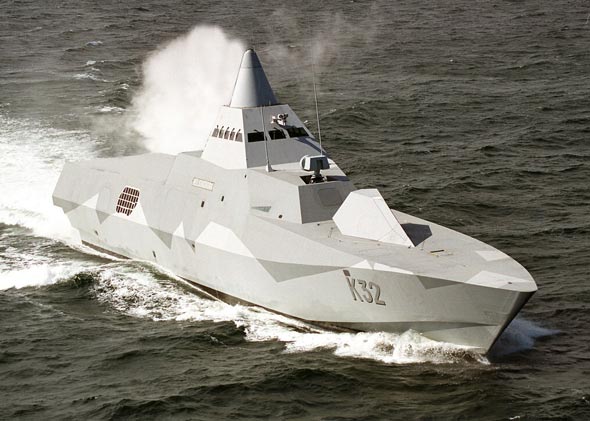Visby - the total stealth concept
Stealth technology is revolutionising naval tactics throughout the world and signifies a major technical advance. Having rewritten the rulebook on air warfare, the stealth concept is now changing the naval seascape too. A new naval era has been launched.
The decision to invest in this new technology was taken by the Swedish Government as early as October 12, 1995. One of the key issues addressed at that time was the need to halt the spiralling costs of defence spending, while continuing to invest in the future, to achieve multimission capability at a relatively low cost.
The Visby-class corvette is the first naval vessel to feature fully developed stealth technology. She is being built in carbon fibre and will be very difficult to detect with radar. In all, five vessels are on order at Kockums with an option on vessel number six. The Swedish Defence Materiel Administration (FMV), which has ordered the vessels on behalf of the Swedish Navy, has been involved in the technical development and planning of the project.
Visby is a victory for what has become known as the "Swedish Model". The development of the new concept is the result of close collaboration between Kockums, FMV and the Swedish Navy. The concept that now has been realised is founded on seven year´s experience with the "Smyge" prototype and technology demonstrator, and is therefor well proven and tested. Sweden´s experts in the field of stealth technology, including research scientits from Sweden´s internationally respected Royal Institute of Technology (KTH) in Stockholm, have all participated in the project. Involved in the project are also Saab, Ericsson Microwave Systems, Bofors Defence, GDC, General Dynamics Canada and others.
Flexible surface combat vessel
The Visby-class vessels are flexible surface combat ships, which offer excellent performance characteristics in both the high-speed and low-speed roles. They are as effective in the mine clearance and ASW (Anti-Submarine Warfare) roles as in the mine-laying, surface combat, underwater defence and air defence roles. They also possess extremely high capacity in the surveillance, combat management and communications roles. Minimal radar and noise signatures, good magnetic properties and high impact-resistance significantly enhance the vessel´s active self-defence systems. The Visby corvette is, quite simply, a completely new type of naval vessel, featuring revolutionary technology that is eminently well adapted to the needs of the new, modern defence force currently being built up.
The Visby corvette is designed to keep signatures to a minimum. The hull features large, flat surfaces and sharp edges. Anything that is not absolutely essential on the outside of the hull or superstructure (which is not much!) has been built into the main body of the ship, or stays hidden under hatches. To ensure a minimal IR-signature, the gas turbine exhaust pipes and emissions are specially, shielded at the stern, close to the surface of the water. The hull is entirely non-magnetic, and onboard equipment is either demagnetised or constructed of non-magnetic materials.
Good seagoing qualities
The hull has been optimised for the best possible seagoing qualities, combining excellent course stability with extreme manoeuvrability. It has been specially designed for water-jet propulsion. It became apparent at an early stage of development that an extremely low hull weight at reasonable cost would be decisive to the vessel´s overall performance and combat efficiency. To satisfy these requirements without compromising on performance specifications, the hull is of sandwich design, featuring a PVC core with a carbon fibre/vinyl ester laminate. This combines high strength and rigidity with low weight and good shock-resistance characteristics.
The stealth concept comprises everything that serves to minimise signatures ands signals, either to enhance one´s own countermeasures and sensors or to make detection and identification by an opponent more difficult  or impossible. In the collaboration with its owner, Germany´s HDW Group, Kockums is now engaged on the development of a somewhat larger export version of Visby, which will be introduced on the international market. The stealth-vessel concept has already attracted keen interest on this market.
Common reactions to Visby
On first seeing Visby, a common reaction is a degree of scepticism about whether she is tough enough to do the job. In fact, carbon fibre is amazingly durable, and can take more punishment than steel. Used in space for many years now, the material has proved to be extremely tough. Another common reaction on seeing a picture of Visby is "that´s not a real photo; it´s computer animation, isn´t it? But she´s special looking because she´s designed to avoid detection by radar, IR cameras and similar sensors. When correctly handled, the choice of material and the way she is constructed should make her almost invisible.
A new era of naval tactics has begun.
Together HDW and Kockums has constructed Visby Variants for the export market.Time to seriously consider Visby as a replacement of our Victory class corvettes?





